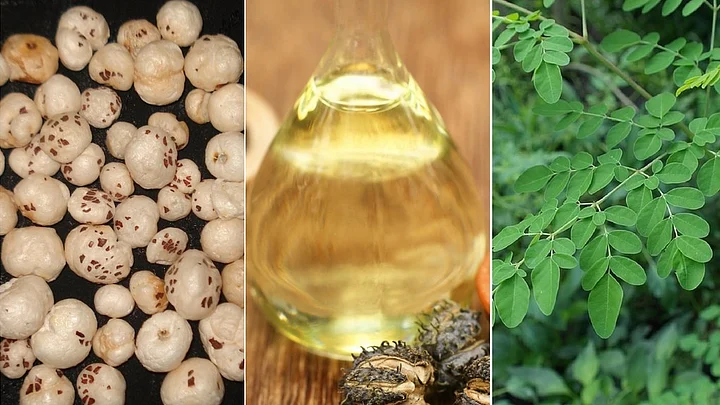Indian food items boast some of the best natural medicines, health secrets and home remedies that have the ability to provide a therapeutic effect no man-made drug ever can.
Just think about our grandmothers. What’s the first thing they’d do if someone fell sick? They’d rush to brew some kadha. Some haldi doodh would always do the trick for those who were unable to sleep. Our ancestors always had these remedies at their fingertips.
But despite having the best food, the best natural medicines, the best lifestyle and the best culture, why are we getting sicker and sicker? It is because over the years, we have gradually moved away from our roots and have started aping the West.
The problem is, in our honest attempt to eat healthy and lose weight we are now introducing foods on our plate we never grew up on.
A number of ‘superfoods’ that have always been on the plates of Indians have now begun to take the world by storm. Companies are minting money off these foods, with several people flocking to these foods in a bid to eat healthier.
These foods are popularly known as the ‘miracle foods’ or ‘superfoods’ because that’s what they exactly are. Here’s a quick look:
Turmeric/Haldi
The use of turmeric in India dates back to 5,000 years. It is one of the most common remedies that Indian households turn to for ailments like sore throat, cough, flu and even insomnia.
Turmeric is packed with immunity boosting properties. It is antibacterial, antimicrobial, antifungal and is a potent antioxidant. Add some ginger and pepper and you can further enhance its health boosting powers. It is small wonder why masala chai has so many fans all over the world.
Western countries call turmeric the golden spice because of its bright yellow hue. The spice began to see a spike in its popularity of late, after the introduction of the Turmeric latte, which was first introduced in San Francisco.
Several health cafes all around the world offer 'Turmeric Mylk' ( ‘y’ for being non-dairy) to customers who are willing to pay a premium price for it.
This is nothing but the familiar haldi doodh. Tell your granny about it. She’ll have a good laugh!
Lotus Seeds/Makhana
Forget popcorn. It’s time for foxnuts/makhana!
With popcorn being linked to inflammation, cardiovascular diseases, and hormonal problems, foxnuts have become the next best swap.
But our grandmothers have, since time immemorial, roasted these white, cotton-like balls with a bit of ghee, salt and pepper until crunchy. Sometimes, they’d make kheer out of it.
Foxnuts are low in calories, rich in fibre and high in antioxidants. They contain highly alkaline minerals like calcium, magnesium, potassium and zinc.
It’s interesting to see how the humble makhana is now sold in a variety of flavours like Mexican, Cheese and Onion or Chipotle in western wholefood stores.
Clarified Butter/Ghee
Cow ghee is considered to be one of the purest food items as per Indian culture. It has been mentioned in different Yogic and Ayurvedic texts.
Right from the time a child is born, he’s fed or massaged with ghee to strengthen bones, lubricate joints and build immunity.
Ghee is also known for its beauty and brain enhancing powers. With the increase in awareness around refined oils, canola oils, soybean oil and their link to cardiovascular diseases, many are flocking to ghee as the preferred cooking oil.
This is because ghee has a high smoking point, is rich in Vitamin A,D,E,K and can reduce cholesterol.
Moringa/Drumstick Leaves
You may have seen supplements/powders/teas of labeled moringa in a health food store and wondered about its origin.
Moringa is nothing but leaves of the drumstick, which is used in the sambhar. In rural India, the leaves and flowers of moringa are cooked into curries, sometimes using rice starch.
Moringa, propagated as a superfood by World Health Organisation (WHO), helps boost immunity, iron levels, calcium and Vitamin A, C, E. It has the potential to repair cells – making it an effective tool to battle cancer, diabetes, ageing and malnutrition, among other ailments.
Castor Oil
Our grannies have always used castor oil packs to address any body pain, be it arthritis or menstrual cramps and the superfood is now attracting health fanatics worldwide.
In India, castor oil has been used to alleviate a number of health problems, including constipation, muscle cramps, joint pain, and colic pain in infants.
It has also proved to be an effective remedy to clear up mucous and acne. It helps detoxify lungs, nourishes skin and helps boost lymphocytes.
Coconut Oil
Using coconut oil for cooking and oil-pulling may be a new trend. But not in India. Raw cold pressed virgin coconut oil is one of nature’s most therapeutic oils. And its use dates back 3,000 years.
Pure coconut oil has proven to be an effective armour against viruses, bacteria, infection, cancer, thyroid and brain and heart problems. Its undoubtedly nature’s medicine for an under active thyroid. What’s more, it helps beautify skin and burn fat, too!
There are really no limits to what coconut oil can do; but in conjunction with other lifestyle changes, of course.
(Luke Coutinho is M.D. Alternative Medicine (Integrative & Lifestyle) & Holistic Nutritionist. Luke treats patients with disease and specializes in cancer with a holistic and integrative approach worldwide.)
(At The Quint, we question everything. Play an active role in shaping our journalism by becoming a member today.)
